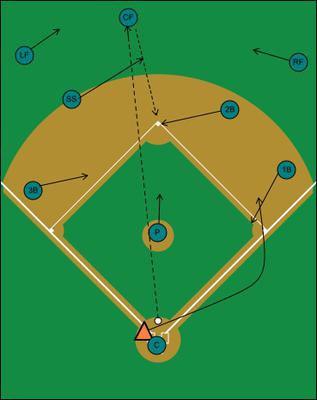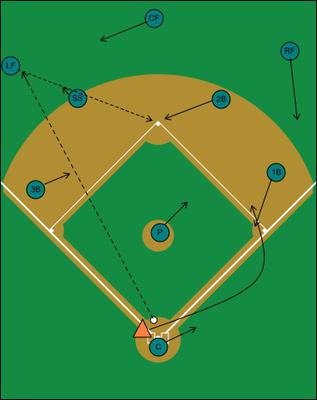SHOULD A 12 YEAR OLD BE LEARNING TO THROW TO A BASE WHEN NOBODY'S THERE?

Single to right, no runners on base

Single to center, no runners on base

Single to left, no runners on base
Anonymous asked: My 12 year old beginner was taught to throw to 2nd base when a ball rolls to him in right field.
The thing that bothered me was that nobody was at the base, and again he's a beginner.
Later, he was told to use his judgment after he threw the ball to the base when a player ran out to cut the ball.
I'm wondering if this will cause confusion for a beginner.
Rick answered: Thank you for your question.
The images above are the defensive player positions for the scenario you have asked about, as well as the same scenario in center and left field.
The defensive objective in these situations, is to keep the batter-runner at first base.
Should the runner not make an attempt to try to go to second base, the infielder coming out can cut the ball off, and run it back into the infield. That helps prevent an overthrow by the outfielder at second base, which could result in the runner ending up at 3B.
Outfielders are taught to throw the ball "through" the cutoff man. That throw should be head high on the cutoff man, which provides the cutoff man an opportunity to cut the ball or let it go.
The shortstop, in this case, is covering 2B and is responsible for telling the cutoff man to cut the ball. If he doesn't say anything, the cutoff man lets the ball go through.
As you can see in the diagrams, every player on the defensive team has someplace they are supposed to be on every ball hit. If they find themselves standing around, they are wrong. They should be moving to someplace.
To answer your question about throwing to a base no one is covering, no he shouldn't do that. Someone is assigned to be at that base. If there is no one there, and no cutoff man lined up to throw to, he has the option to run the ball into the infield himself, or throw to the nearest infielder. One way or another, the ball needs to get back into the infield as quickly as possible, and as close to the base in question as possible.
This situation is the least complicated of the many that can come up.
As players begin to learn the game, these cutoff scenarios can become confusing. Diagrams can help some; but the reality is they need to learn them in drills set up during practice to physically go through the tasks involved, where a coach can break down each part in real time, explaining why they go where they do, not just that they have to go there.
If you go to defensive situations on my site, you will find some additional information on the overall situation, as well as links to all the diagrams for all the situations that could be encountered at some point in time.
Your son will undoubtedly be somewhat confused for a while; everyone is when they start out. He will get there.
All these situations are the heart of defensive baseball. There are truly a vast number of things that an offense can throw at a defense. That is one of the many reasons baseball is the great game that it is, an easy game to play, a hard game to master.
Good luck as you and your son move forward. You are building some wonderful, lasting family memories.
Yours in baseball,
Rick
Click here to post comments
Join in and write your own page! It's easy to do. How? Simply click here to return to Ask The Baseball Coach.
|





